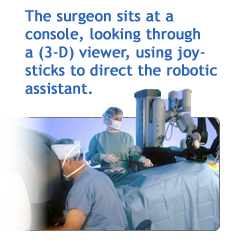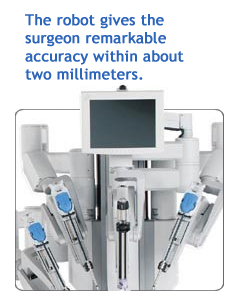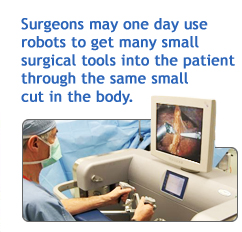 This is already reality: You are scheduled for surgery. Your surgeon is skilled, precise, and manipulates tiny instruments in the smallest openings in your body. You’re left with few noticeable scars, or none at all. What’s more, your remarkable surgeon can easily perform difficult procedures that were "impossible" just a few years ago.
And he’s not super human. He’s not even human. "He" is a robot.
Already, tens of thousands of robotic surgeries are performed in the U.S. every year on prostate glands, hearts, gallbladders, and other parts of the body. And more remarkable medical robotic tools -- including some that enter the body without needing an incision -- are right around the corner.
 High-tech edge for patients and docs
Of course, human doctors aren’t turning over their patients to humanoid machines. But they are using high-tech robotics to help them do diagnostic and surgical procedures. The result is less trauma, less damage to the body, fewer risks, and shorter hospital stays for many patients.
There are many pluses for surgeons, too. For example, operations can last for many hours, causing physical fatigue, sometimes resulting in tremors in a surgeon’s hand. A surgeon controlling a robotic arm, however, works with a computer program that eliminates any tremors and keeps the robotic surgery precise and steady.
The surgeon sits at a console, looking through a three-dimensional (3-D) viewer, using joysticks and foot controls to direct the robotic assistant. The robot’s never-shaky, never-tired, multi-jointed tools carry out an operation on a gallbladder, cancer tumor, or other health problem with remarkable accuracy.
"3-D high definition vision allows us to precisely locate vital structures and anatomy," says Raymond J. Leveillee, MD, chief of the division of endourology, laparoscopy and minimally invasive surgery at the University of Miami. "The robotic instruments have articulating ‘wrists’ that allow for delicate maneuvers, such as suturing and cutting in extremely precise ways, much more so than conventional laparoscopy (minimally invasive surgery using only a small incision). For a patient, there is less bleeding, less anemia, smaller incisions, less pain, and a shorter recovery period."
The downside? Leveillee says it can take some time for surgeons to learn how to work with the new high-tech robotics. But patients, he says, take to the idea of a robot in the operating room quickly.
 Today’s cutting edge
Orthopedic surgeons are increasingly using robotic surgery because it helps the surgeon do precise hip replacements, knee replacements, and soft-tissue operations. In recent years, the MAKO robotic system, which uses CT scans before surgery to make a 3-D model of a patient's knee, has helped orthopedic surgeons create detailed plans for complex partial knee replacements and perform them perfectly. Instead of removing the bone by hand with a burr saw and working by eye, the surgeon uses a robotic arm with a saw. The doctor follows the progress on a LCD screen. A pre-programmed plan prevents even the slightest bit of excess bone and tissue from being removed. The robot minimizes trauma to the knee and gives the surgeon remarkable accuracy within about two millimeters -- about the width of a wedding ring.
Surgeons also use robots to perform heart bypass surgery, re-opening clogged blood vessels and getting more oxygen-rich blood to the heart, instead of opening the chest up in the traditional operation. They can also use robots to do brain surgery. Canadian doctors made surgical history in 2008 when they used remote controls and an imaging screen to precisely guide a two-armed robot, called the NeuroArm, in a delicate operation that removed a brain tumor from a 21-year-old woman.
Robotic surgery is also being used to treat cervical and uterine cancer, uterine fibroids, endometriosis, uterine prolapse, and excessive bleeding. And because the high-tech operations can offer easier access to some of the more difficult-to-reach abdominal and gastrointestinal areas, surgeons are using them for some gastric bypass and colon resection surgeries, and for gallbladder removal and surgery on the esophagus.
Miami’s Leveillee uses the da Vinci robotic surgery system for many kinds of surgery in the pelvic region, including for prostate cancer and urinary problems. In fact, men needing prostate operations make up the biggest group to go under the robotic knife. Surgeons now use this system in many hospitals worldwide.
Last year, University of Chicago Medical Center surgeons made a first when they used a robot to reconstruct the bladder of a 10-year-old Chicago girl born with an abnormally small bladder she could not control.
Robotics on the horizon
 The high-tech tools of tomorrow will be even more futuristic. Although endoscopy (using a camera mounted on a flexible tube to see inside the body) is now common -- and even preferred -- in many surgeries, scientists are investigating flexible endoscopy that’s controlled remotely from a console. That opens the possibility of transmitting images from inside a patient at a remote clinic to a doctor in a hospital thousands of miles away.
Leveillee predicts that surgeons may one day use robots to get many small surgical tools into the patient through the same small cut in the body, making surgery even more technical but less traumatic for the patient. "It’s the external cuts that hurt, not the internal ones," he says.
Some medical centers have used ingestible, pill-sized video cameras for several years to diagnose bowel diseases. But next on the high-tech medical agenda are robotic devices that can enter the body -- through natural orifices or cavities -- to not only take a look inside but also treat disease.
No one expects robotic devices to fully replace human doctors, but their place alongside physicians is here to stay.
Here are a few newer technologies you may see during an operation on you someday:
- Natural orifice transluminal endoscopic surgery, or NOTES. It works without any skin incisions at all. For example, last fall surgeons reported at the Society of American Gastrointestinal and Endoscopic Surgeons Annual Scientific Session that they had successfully removed 7 gallbladders through the mouths of patients. Just this past January, Yale-New Haven Hospital surgeon Kurt Roberts, MD, used a remote-controlled telescopic instrument to remove a woman’s appendix through a small incision inside her vagina. Other uses of this technique, including for the removal of organs such as the ovaries and fallopian tubes, are expected to follow.
- A mechanical flexible robot called i-Snake (also NOTES technology). It enters the patient’s mouth, or another orifice, and slithers through the body to help doctors perform internal surgery. Developed by robotic surgery experts at the Hamlyn Centre for Robotic Surgery at Imperial College in London, the i-Snake is a long tube that carries special motors, sensors, and imaging tools into the body. Researchers hope to use the robot to diagnose and treat medical problems deep inside the gut and bowel, as well as for heart bypass surgery.
- Robotic probes could one day combine several procedures -- allowing a surgeon to do a breast biopsy, find and diagnose cancer, and then treat it, all during an MRI. Sound far-fetched? The University of Maryland School of Medicine is working on just such a prototype.
- Microbots. These miniature robots would merge sensing and imaging technology, and "swim" through human arteries. An article in the January 2009 issue of the Journal of Micromechanics and Microengineering details how researchers in at Australia's Monash University are designing micro-motors, just a quarter of a millimeter in size, that would propel microbots injected into humans to treat stroke victims and open blockages in arteries.
|